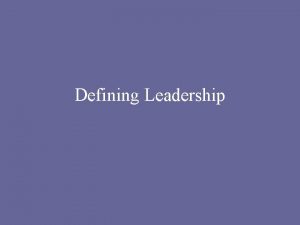POSITIVE LEADERSHIP ALDA GONZALEZ DEFINING POSITIVE LEADERSHIP Positive






- Slides: 6

POSITIVE LEADERSHIP ALDA GONZALEZ

DEFINING POSITIVE LEADERSHIP • Positive Leadership Theory (PLT) suggests that leadership is most effective and most likely to enable extraordinary performance when individuals accentuate what is right, what is inspiring and what is good in organizations. (Cameron 2008) • Major question: “How can organizations develop a leadership capacity that enables people to reach their full potential and fosters extraordinary performance that exceeds expectations? "

POSITIVE LEADERSHIP FOUNDATION The PLT is founded in the following three steps: • Strength-Based Leadership – Focusing on what the follower is already good at and building upon it • Positive Development Cycle – Learning sets the foundation for future learning, when the learning is built upon it results in reinforcement of prior learning. • Positive Relationship & Connections – Being able to relate to your follower and establishing mutuality eliminates the conflict of leader and follower identities.

POSITIVE LEADERSHIP IN ACTION • Build on what is already excellent • Support and reinforce others leadership identity • Foster positive development cycles with consistency • Allow for experimentation and new ideas this results in learning and development • Be a resource to those that follow • Validation offers reinforcement that one ‘s role is valued and has purpose

CONCLUSION • Positive Leadership Theory builds upon peoples current capabilities to be leaders and uses their strengths to create growth and development. In addition to fostering positive development cycles and establishing a relationship with the follower. • The following slide is additional information on a similar theory called Appreciative Inquiry that I believe relates to PLT and supports theory even further.

SIMILAR THEORY: APPRECIATE INQUIRY(AI) • AI begins by identifying this positive core and connecting to it in ways the heighten energy, sharpen vision, and inspire action for change. • Takes what’s right and builds on it in, this theory uses appreciative approach to bring collaborative and strength-based change.











